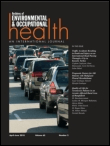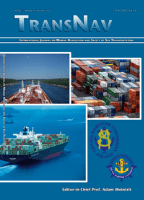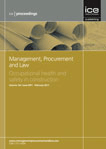
SAFETY SCIENCE
Scope & Guideline
Shaping policies with evidence-based safety research.
Introduction
Aims and Scopes
- Safety Management and Culture:
The journal emphasizes the study of safety management systems and organizational safety culture, exploring how these factors influence safety behaviors and performance in different industries. - Risk Assessment and Mitigation:
A significant focus is on methodologies for assessing and mitigating safety risks, including quantitative and qualitative approaches to evaluate hazards in various environments. - Human Factors and Ergonomics:
Research on human factors and ergonomics is prevalent, examining how human behavior, cognition, and physical capabilities affect safety outcomes in occupational settings. - Technology and Safety Innovations:
The journal covers the impact of emerging technologies, such as virtual reality, artificial intelligence, and IoT, on safety training, risk assessment, and operational safety. - Emergency Preparedness and Response:
Studies related to emergency management, evacuation strategies, and resilience in crisis situations are frequently published, contributing to better preparedness for disasters. - Health and Safety in High-Risk Industries:
There is a consistent focus on occupational health and safety in high-risk sectors such as construction, aviation, and healthcare, with research aimed at improving safety practices and reducing incidents.
Trending and Emerging
- Intersection of Mental Health and Safety:
Recent publications increasingly explore the relationship between mental health and safety performance, recognizing that psychological well-being is crucial for maintaining safety in the workplace. - Data-Driven Safety Management:
There is a growing trend towards leveraging big data, machine learning, and artificial intelligence for predictive safety analytics, enhancing risk management capabilities. - Safety in the Context of Pandemics:
The COVID-19 pandemic has spurred a significant increase in research related to workplace safety in health crises, focusing on emergency preparedness, response strategies, and the health impacts of pandemics. - Sustainability and Safety Integration:
Emerging research is focusing on integrating sustainability with safety management practices, reflecting a broader societal push towards environmentally and socially responsible safety solutions. - Community and Social Aspects of Safety:
There is an increasing emphasis on community-based safety research, exploring how social dynamics and community engagement influence safety behaviors and outcomes.
Declining or Waning
- Traditional Safety Compliance:
Research focusing solely on compliance with safety regulations is becoming less prevalent, as there is a shift towards integrating safety culture and proactive safety management practices. - Generic Risk Assessment Models:
There has been a noticeable decline in the publication of generic risk assessment models that do not consider specific contextual factors, with a growing emphasis on tailored and dynamic approaches. - Single-Dimensional Safety Indicators:
The use of single-dimensional safety indicators for measuring safety performance is waning, as researchers and practitioners increasingly advocate for multidimensional and leading indicators. - Passive Safety Systems:
Research on passive safety systems without considering active safety management strategies is declining, as there is a move towards more integrated safety solutions. - Historical Analysis of Safety Incidents:
While still relevant, the historical analysis of past incidents is receiving less attention compared to forward-looking studies that emphasize innovation and future safety challenges.
Similar Journals

Archives of Environmental & Occupational Health
Exploring the vital connections between work and wellness.Archives of Environmental & Occupational Health is a prestigious journal published by Routledge Journals, Taylor & Francis Ltd, dedicated to advancing research and knowledge in the realms of environmental science, occupational health, and toxicology. With an ISSN of 1933-8244 and an E-ISSN of 2154-4700, this peer-reviewed journal has gained significant recognition, currently holding a Q2 ranking in Environmental Science and Q3 rankings in Health, Toxicology and Mutagenesis, and Public Health. Established in 2005, it serves as a vital platform for researchers, practitioners, and policymakers alike who aim to address and disseminate findings on pressing environmental and occupational health issues. The journal is not open access, allowing for rigorous peer review processes while still reaching a broad readership. As it converges through 2024, the Archives of Environmental & Occupational Health continues to play a critical role in shaping discourse and fostering innovation in the field, making it an essential resource for those committed to improving both human health and the environment.

Workplace Health & Safety
Transforming workplace practices through rigorous scholarship.Workplace Health & Safety is a prominent peer-reviewed journal published by SAGE Publications Inc, aiming to advance the field of occupational health and safety through rigorous research and practical applications. With an impact factor reflecting its significant contributions to the fields of nursing and public health, this journal ranks in the second quartile (Q2) for both Nursing (miscellaneous) and Public Health, Environmental and Occupational Health, showcasing its standing among peers. Since its inception in 2003, the journal has been committed to disseminating insights that enhance workplace safety and health practices, making it a vital resource for researchers, professionals, and students alike. Readers can access a wealth of knowledge through its open access option, fostering a broader understanding and discussion around critical health and safety issues in various work environments. With a consistent commitment to excellence and relevance, Workplace Health & Safety is essential for anyone dedicated to improving workplace environments and promoting health and safety standards.

OCCUPATIONAL AND ENVIRONMENTAL MEDICINE
Advancing health in workplaces and communities.OCCUPATIONAL AND ENVIRONMENTAL MEDICINE is a leading academic journal dedicated to the field of public health, with a specific emphasis on environmental and occupational health. Published by the esteemed BMJ PUBLISHING GROUP, this journal has established itself as a crucial resource for researchers, professionals, and students alike, achieving a remarkable impact factor that reflects its high-quality research contributions. With a distinguished Q1 ranking in its category and a strong position in Scopus rankings—placing it at #59 out of 665—this journal showcases top-tier studies and findings from 1994 to its anticipated convergence in 2024. Set in the United Kingdom, the journal aims to advance understanding and practices relating to health in the workplace and environmental settings, making it an indispensable platform for the dissemination of knowledge in this vital area. Although not an open-access journal, it provides a valuable repository of articles that influence policy and practice worldwide, ensuring that critical information is accessible to those dedicated to promoting safer, healthier working and living environments.

Journal of Space Safety Engineering
Shaping the future of aerospace safety through rigorous research.The Journal of Space Safety Engineering, published by ELSEVIER, is a pioneering platform dedicated to advancing the field of aerospace safety and engineering. Since its inception in 2014, this journal has catered to researchers and professionals focusing on the crucial intersection of aerospace engineering and safety, risk, reliability, and quality management. With an ISSN of 2468-8975 and E-ISSN of 2468-8967, it has established itself within the academic community, currently holding a Q3 ranking in both Aerospace Engineering and Safety, Risk, Reliability, and Quality categories, according to the 2023 metrics. The journal, which covers converged years up to 2024, is instrumental for those seeking to explore innovative safety solutions in space missions and exploration, making it an essential resource for students, industry professionals, and researchers alike. Although it is not open access, it remains a credible source of impactful studies that contribute to enhancing safety protocols and engineering practices in aerospace endeavors. With a strong focus on rigorously vetted research, the Journal of Space Safety Engineering ensures that important advancements in this dynamic and vital field are shared widely among experts and stakeholders.

Fire Safety Journal
Uniting disciplines to enhance fire safety practices.Fire Safety Journal, published by ELSEVIER SCI LTD, is a premier interdisciplinary journal that disseminates cutting-edge research and innovation in the field of fire safety, risk management, and fire protection engineering. With an impressive impact factor reflecting its significance in multiple domains, including Chemistry (Q1), Materials Science (Q2), and Physics (Q1), this journal serves as a vital resource for researchers, practitioners, and policymakers dedicated to improving fire safety standards and minimizing risks associated with fire. The journal's ISSN is 0379-7112 and its E-ISSN is 1873-7226, ensuring broad accessibility and distribution within academic circles. Since its inception in 1977 and continuing through 2024, Fire Safety Journal has maintained a commitment to advancing knowledge and the sciences relevant to fire hazards, offering a platform for research that spans building construction, material safety, and risk analysis. As one of the highly regarded publications in its field with notable rankings across various categories in Scopus, the journal empowers a community of experts striving for innovation and excellence in fire safety.

Indian Journal of Occupational and Environmental Medicine
Transforming Insights into Action for Healthier WorkplacesIndian Journal of Occupational and Environmental Medicine, published by Wolters Kluwer Medknow Publications, is a pivotal resource in the field of public health, focusing on the critical intersections of occupational safety and environmental health. With the ISSN 0973-2284 and E-ISSN 1998-3670, this journal has been a beacon of knowledge since its inception in 1999 and continues to influence scholarly discourse through its convergence years culminating in 2024. Recognized for its contribution to the field with a 2023 Scopus categorization of Q3 in Public Health, Environmental and Occupational Health, it has secured its place among the top journals, ranked #453 out of 665 within its specialty, reflecting a respectable 31st percentile. While it operates on a subscription basis, the journal ensures comprehensive coverage of significant research, thereby enhancing occupational health practices and environmental health policies. It serves as a vital platform for researchers, professionals, and students dedicated to advancing knowledge and improving outcomes in these crucial areas of health. The journal's commitment to excellence is evident as it continues to cater to a diverse readership from its base in Mumbai, India.

Journal of Patient Safety and Risk Management
Navigating the complexities of healthcare risk with expertise.Journal of Patient Safety and Risk Management, published by SAGE Publications Ltd, stands as a vital resource for the exploration and discourse surrounding safety and risk in healthcare environments. Established in 2018 and continuing through 2024, this journal delivers a rich repository of knowledge aimed at improving patient safety protocols and mitigating risks within healthcare systems. With an ISSN of 2516-0435 and an E-ISSN of 2516-0443, the journal is indexed in several categories with a notable performance in Health Policy and Health (social science), rated in Q3, while also addressing Leadership and Management in Q4. Despite the absence of an open access model, the journal provides a platform for researchers, healthcare professionals, and students to stay informed about the latest developments and evidence-based practices within the dynamically evolving landscape of patient safety. Given its Scopus rankings, which include a percentile of 46th in Health (social science) and 36th in Health Policy, the journal is positioned as a credible and impactful publication for those dedicated to enhancing patient care through robust risk management strategies.

TransNav-International Journal on Marine Navigation and Safety of Sea Transportation
Transforming Maritime Practices with Innovation.TransNav - International Journal on Marine Navigation and Safety of Sea Transportation is a leading scholarly publication that addresses the critical themes of marine navigation and maritime safety. Published by Gdynia Maritime University in Poland, this open-access journal has been a vital resource since its inception in 2007, fostering a global dialogue among researchers, maritime professionals, and students. With an impressive trajectory of convergence from 2019 to 2024, TransNav is recognized for its impact in the realm of Ocean Engineering, Oceanography, and Transportation, holding a notable Q3 ranking in Ocean Engineering and Q4 rankings in both Oceanography and Transportation for 2023. The journal serves as an essential platform for disseminating research findings and advancements that enhance safety protocols and navigation strategies in sea transportation, thus contributing to the sustainability and efficiency of maritime operations worldwide. Researchers can access its wealth of information through various academic databases, ensuring that your work remains on the cutting edge of this vital field.

Medycyna Pracy-Workers Health and Safety
Elevating safety standards for a healthier workforce.Medycyna Pracy - Workers Health and Safety is a distinguished open-access journal published by the NOFER Institute of Occupational Medicine in Poland, dedicated to advancing the field of occupational health and safety. Established in 1953, this journal has evolved to provide a vital platform for researchers, practitioners, and students to disseminate their findings and insights regarding worker health and well-being. With a Q3 ranking in both Medicine (miscellaneous) and Public Health, Environmental and Occupational Health categories, it reflects a commitment to high-quality scholarship despite its recent Scopus percentile (35th). The journal's rich history encompasses issues from 1953 to the present, allowing for a comprehensive examination of trends and developments in the field. Since adopting an open-access model in 2013, Medycyna Pracy has broadened its reach, ensuring that critical research is freely available to anyone seeking to enhance workplace safety and health outcomes. By fostering dialogue among multidisciplinary professionals, this journal aims to impact policy, practice, and education in occupational health, making it an essential resource for anyone engaged in this vital area of study.

Proceedings of the Institution of Civil Engineers-Management Procurement and Law
Innovating practices in civil engineering management and procurement.Proceedings of the Institution of Civil Engineers-Management Procurement and Law is an esteemed academic journal published by Emerald Group Publishing Ltd, dedicated to advancing knowledge in the fields of management, procurement, and law as they pertain to civil engineering. Operating from the United Kingdom, the journal covers a broad spectrum of topics, reflecting its interdisciplinary nature, and it is indexed with significant rankings, including Q3 in Business, Management and Accounting as well as Civil and Structural Engineering, and Q2 in Safety, Risk, Reliability and Quality for the year 2023. With its publication history extending from 2008 to 2024, it serves as an important platform for researchers, professionals, and students to engage with contemporary issues and innovations. Although it does not offer open access, the rigorous peer-review process ensures high-quality contributions, making it a vital resource for anyone involved in the civil engineering sector. The journal continues to influence best practices and policy-making in the industry, underscoring the crucial link between engineering management, procurement protocols, and legal considerations.